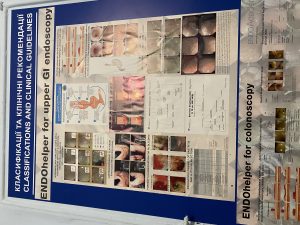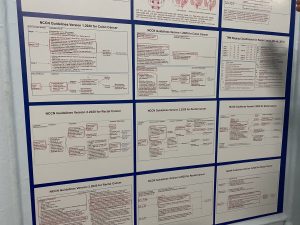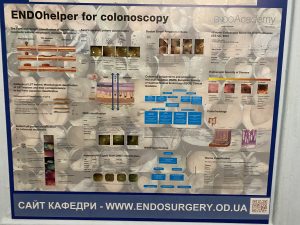
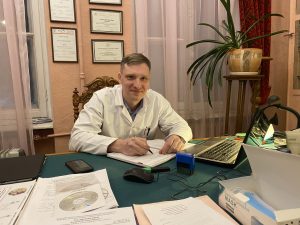
Operations with long rehabilitation, large scars and temporary disability are a thing of the past. Now even the most difficult surgeries can be performed without an incision – just a few punctures of the skin. This approach is as gentle as possible for the patient – they are usually discharged on the second or third day. This method is called laparoscopy. In the world’s leading clinics, complex laparoscopic operations are performed using robots. Odessa National Medical University is intensively developing laparoscopic surgery and performing operations of a high level of complexity, which can be used in robotics. How modern technologies restore patients’ health and protect them during the Covid-19 pandemic – in an interview with the head of the Department of Robotic and Endoscopic Surgery of ONMedU, Professor Andriy Malinovskii.
How was the department created and what tasks were set for it?
Our rector, academician Valeriy Zaporozhan, has long harbored the idea of creating a specialized department that would deal with modern minimally invasive surgery. The department, located on the basis of the University Clinic, solves a threefold task: ensuring a single educational, scientific and medical process. The work is carried out at all levels, from students to postgraduate courses for doctors. Our department is one of the few in all of Ukraine, where interns from the first year of study take an active part in laparoscopic operations. The department is equipped not only with modern equipment for surgery, but also with our pride – robotic virtual simulators. Students and trainees practice laparoscopic and endourological operations and endoscopic diagnostics on the simulators. These are our main directions.
Does the department have a special department at the University Clinic?
Yes, it is a department of endoscopic and oncologic surgery. The department is small – 15 beds. Now we load it by 30% via Covid-19. About 500 operations were performed last year. Given the number of beds and the complexity of the operations themselves, this is a good number. We specialize in complex laparoscopic operations, which are not performed in all clinics. For example, few people “on the stream” deal with hernias of the esophageal orifice of the diaphragm. This is a disease in which part of the stomach is fixed in the chest, the main symptom is heartburn. According to statistics, 20% of the adult population in developed countries experience heartburn. That is quite an urgent problem. We have achieved good results in performing these operations, developed original methods of plastic mesh implants. Began to perform operations on obesity. Patients weighing 120-180 kg are difficult to operate. Open operations increase the risks, so they should be done laparoscopically. We remove part of the stomach, suture it to the small intestine and thus remove part of it from digestion. The patient eats less, loses 30-40 kg, hormonal regulation is restored. The operation gives good results for patients with diabetes. But here it is very important to work together with an endocrinologist, a psychologist within a multidisciplinary team. We do interesting operations on the biliary tract. Most clinics use a standard approach: endoscopic removal of stones, and then laparoscopic surgery to remove bile, resulting in two operations. We can do this simultaneously laparoscopically, minimizing complications and ensuring rapid recovery. There are innovations in oncosurgery. For example, the treatment of carcinoma – a common form of cancer, when the tumor spreads throughout the peritoneum. Unfortunately, such patients die in a couple of weeks. They have always been considered inoperable. Now we remove these cells and with the help of special equipment we wash the abdominal cavity with a solution of chemotherapy heated to 40 degrees. Patients live for a year or longer. Compare: a year and a few weeks for stage four cancer.
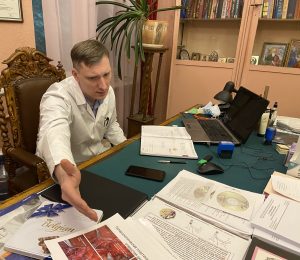
How is minimally invasive surgery developing in Ukraine in general?
If we do not take such large cities as Kyiv and Odessa, in Ukraine minimally invasive operations are performed for about 50% of patients. In the world it is approximately 90%. In well-equipped clinics with trained specialists, such as our University Clinic, we achieve such a high percentage. This is what we see as our main task – to train specialists who will provide such a level of endoscopic surgery in other clinics. Moreover, one of the priority areas for us is minilaparoscopy. What is it? The standard diameter of the instrument in laparoscopic operations is 5-10 mm. We have tools with a diameter of 3 mm. Thanks to the combination of 5- and 3-millimeter tools, it is possible to achieve almost complete absence of pain. The cosmetic result is perfect: after a few months of surgery there are almost no traces! After such operations, patients begin to literally “run”, on the second day they can be discharged. I saw this in Israel, at the Assuta Clinic, where I had a 3-month internship at work. The flow of patients, many operating rooms, almost all operations – from simple to the most complex – are minimally invasive. At the time, it seemed to me that in our reality this was unattainable. After all, we are accustomed to a different approach, so that the patient lay down for three days. And yet we began to apply such treatment protocols to ourselves. The protocol of rapid recovery, for example, includes chewing gum, a cup of coffee in the morning, no drainage and catheters, minimizing drips. I remember we operated on a woman with cholecystitis on Monday morning, and on Tuesday she packed her bags and went home. This approach is called fast-track surgery. And this is very important right now.
You mean during Covid-19?
Certainly. First, the length of hospitalisation of the patient. They spend less time in the hospital, less contact with others. Significantly fewer people are in the clinic at one time. Secondly, purely regime measures. If patients are discharged quickly, they are not visited by relatives. And this, you know, is security, including for staff. We approach this rather harshly. Since September, thanks God, none of our employees and patients have fallen ill. I am convinced that minimally invasive surgery played a role in this. And the third point, important during a pandemic, is distancing oneself from the patient. This, incidentally, is provided by robotic systems. When a robot is on the table, and it is controlled by a surgeon, being a few meters away from the patient. Fewer assistants are involved in operations. This operation is safe for staff if the patient is infected with Covid-19.
You mentioned modern equipment. Tell us in more detail, what do you work on and teach students?
All high technologies are available in our department: we have modern coagulators, tools, optics. We have laparoscopic racks from Karl Storz. This is world-class equipment. Our main rack is equipped with a special fluorescence system. For example, in the process of cholecystectomy, by introducing a special drug and turning on the fluorescence mode, we can clearly see where the common bile duct is. This is important because in technically complex cases it can be damaged. We have already gained a lot of experience – about 30 operations – when this technology saved us. The same technology can be used in oncology to visualize lymph nodes, which allows them to be removed more radically. We are also proud of the 3D laparoscopy stand. You used to have to wear a helmet, it caused some discomfort – you do not see what is happening around you. Now a three-dimensional screen is used, glasses, the surgeon sees everything as in a 3D cinema. This makes it possible to operate in hard-to-reach areas, where you need to sew quickly, intercept the needle. We use this equipment for most of our operations. Video choledochoscope – a unique equipment that helps to enter even a thin bile duct and remove the stone. It is used for the above operations on the bile ducts. The device “Performer” provides circulation of the solution heated to a certain temperature on a contour. It is with its help that hyperthermic chemoperfusion is performed in carcinomatosis.
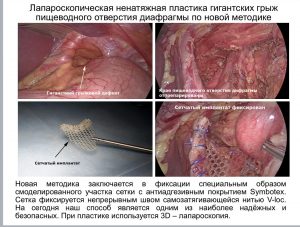
Is the department fully equipped?
We have a strong material base. It would be useful to have a mobile angiograph, or so-called C-arc, which would expand our capabilities in endoscopic bile duct surgery. I would like to add tools for minilaparoscopic surgery to perform them for hernias, as well as tools for bariatric surgery. And, of course, we dream of a robotic system! Why is retrofitting important? Quality equipment is always quality work of a surgeon. This is a reduction in his labor costs, the ability to focus on the patient. Some operations last from 5 hours. The surgeon gets tired, the visual system and hands become overstrained, and tremor appears. As a result, the “human factor” affects the outcome of the operation. Modern robotic systems eliminate all this. The surgeon sits in a chair and controls a robot that can hold instruments at any angle for any number of hours. In addition, some robotic systems have artificial intelligence features that increase the safety of surgery.
How much do such operations cost in Ukraine?
It’s hard to say. There is an objective cost of consumables, there is a price for the depreciation of equipment, the work of the surgeon and the clinic itself. Everything is very individual. For example, obesity surgery is performed in many clinics in Kyiv, Dnipro, and Odesa. But in private clinics they are very expensive – the cost reaches 150-200 thousand hryvnia. We do not have such prices. What is the advantage of university clinics? Here is good modern equipment, modern approaches, we are all academic doctors, “live” in the clinic and constantly learn – these are the basic principles of our work. We focus on the outcome for the patient and on science, not on making money on the patient. People see it. The flow of patients in our department is consistently high.
Are there enough practitioners in Ukraine who are able to work with laparoscopic and robotic equipment?
Endoscopic surgery is constantly evolving, high-level specialists are currently lacking. Simple laparoscopic operations, in principle, are performed even in remote regions, and complex not everyone can do. Such specialists need to be trained, and we have emphasized this. We have selected interns who will work at the department in the future, they are already working in the operating room. All sixth-year students go through us, attending a specialized course in endoscopic surgery, we conduct similar classes with interns. We tried to hold courses for doctors before the pandemic every two months. We have now resumed this work in hybrid mode. By the way, during the quarantine period we have conducted five webinars: on diaphragmatic esophageal hernias, on the basics of laparoscopic surgery and on robotic surgery. We broadcast operations online and at the same time tell what and why we do. This is a very valuable training, and we conduct it in a fairly tight schedule.
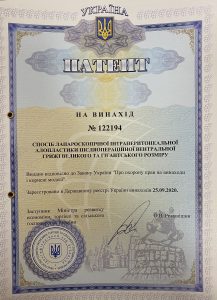
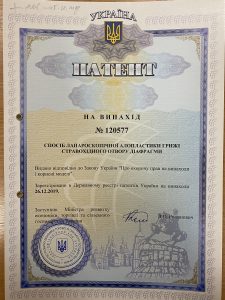
Tell us more about patents. What technologies or devices are we talking about?
The most valuable, in my opinion, patents – from laparoscopic fluorescence and three-dimensional laparoscopy, i.e. from today’s main technologies of advanced imaging. For these operations we have best practices in Ukraine. I also consider valuable patents for the invention of two new methods of plastic hernia of the esophageal orifice of the diaphragm, which make it possible to close large hernia defects with minimal risk of complications. There are several patents for minilaparoscopic surgery. By the way, we were the first in Europe to perform minilaparoscopic fundoplication and cardiomyotomy. I think all these techniques will be successfully applied. We are working on this together with our colleagues.
